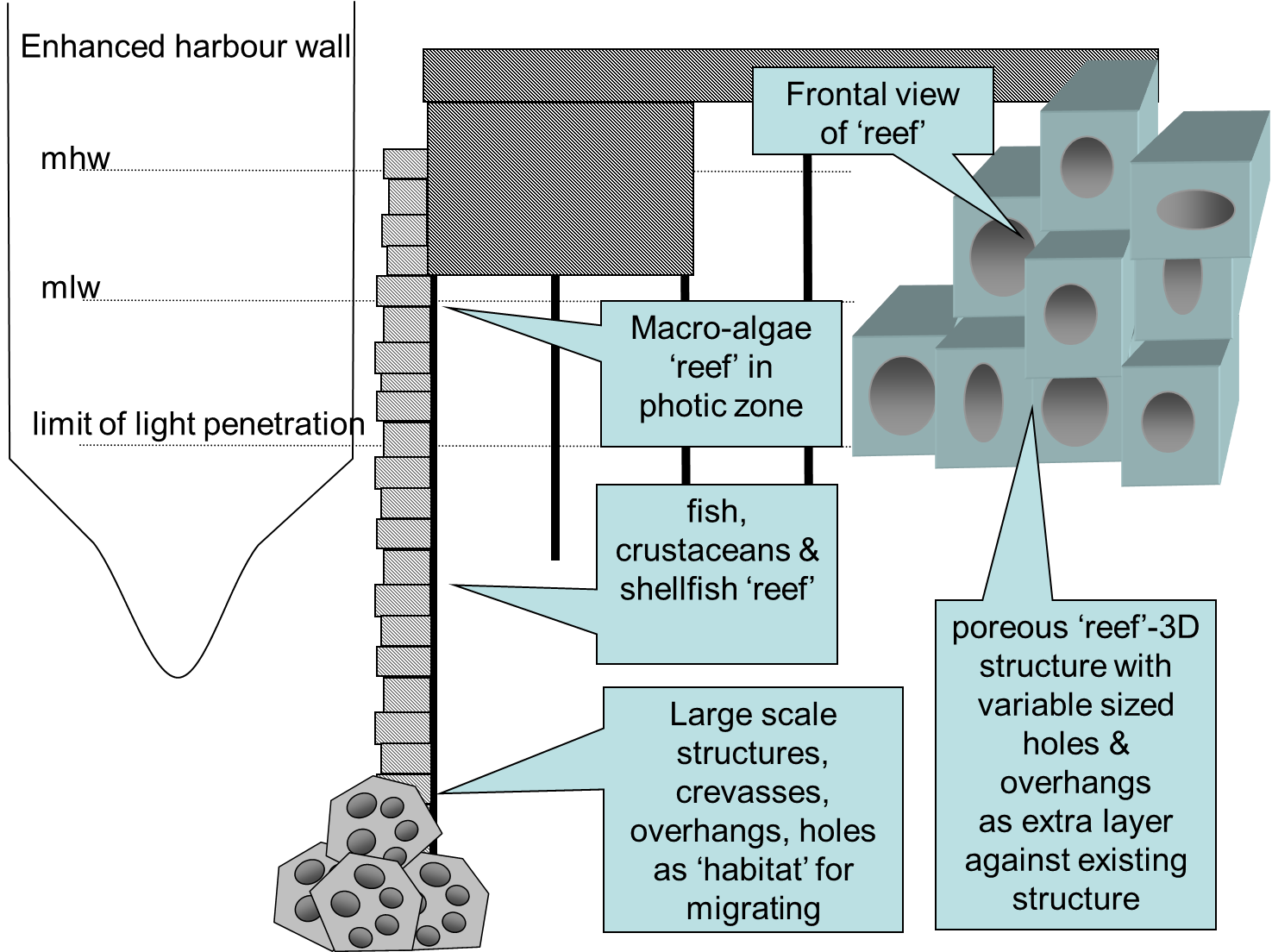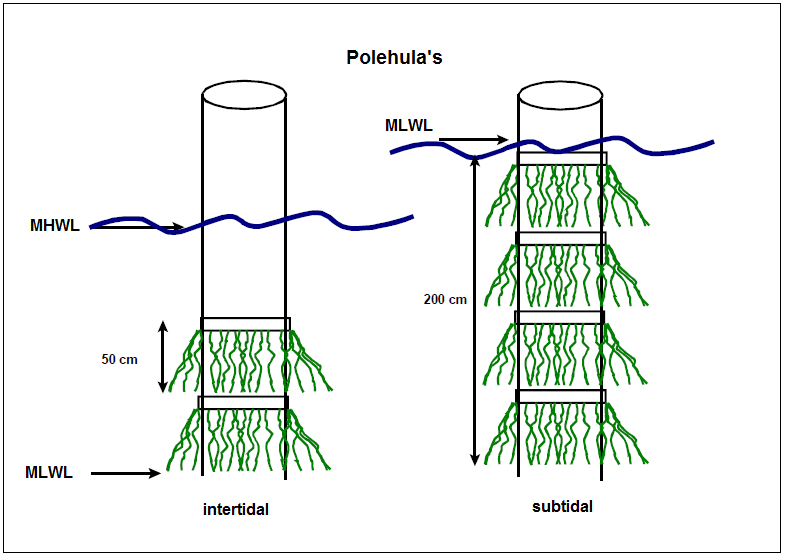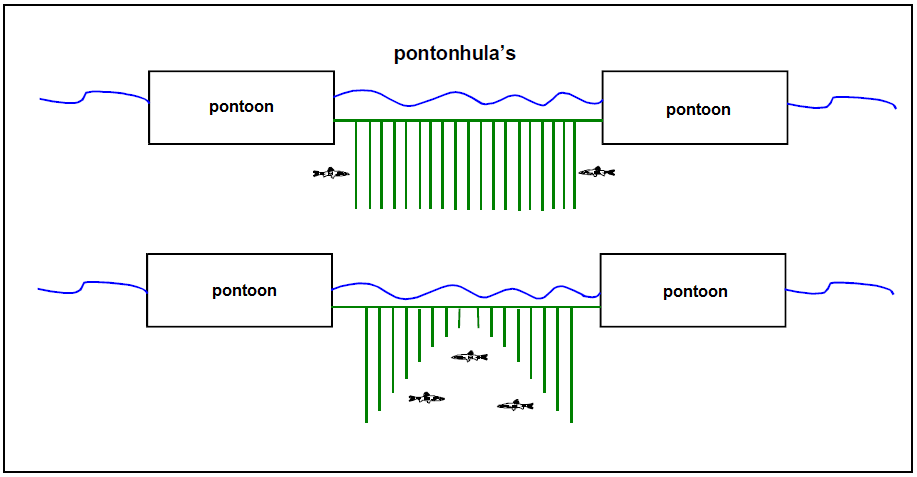Initiation, planning and design
As part of the Rijkswaterstaat Innovation Program (WINN), Deltares sought cooperation with Port Centre Rotterdam. The project and its scope were defined by the parties collaboratively. Ideas developed by Deltares and Ecoconsult as part of the Rich Revetment study and new ideas on the hanging ‘hula’ structures were proposed for implementation in a number of pilot experiments in the Rotterdam harbour.
Pre-feasibility

In the Rich Revetment philosophy, eco-dynamic design scenarios were considered for four habitat types:
- high-dynamic shallow habitats,
- high-dynamic deep habitats,
- low-dynamic shallow habitats and,
- low-dynamic deep habitats.
The fourth habitat type is applicable to most harbour environments and therefore two pilot alternatives were evaluated for this type, namely constructing artificial reef structures and enhancing existing harbour features.
The large amount of hard substrate present in harbours was considered to offer opportunities for epifauna. In this respect, hard substrates can function as artificial reef structures. However, artificial hard substrates usually lack the variety of habitat characteristics of, for example, natural rocky coasts. Therefore, an optimal harbour wall was designed to resemble a natural reef by adding cracks and crevices of distinct sizes, making the wall suitable for colonization by small organisms such as algae, mussels and sponges, as well as by larger organisms such as fish and lobsters. Implementing such a reef wall would require the construction of new walls, which was not feasible for this pilot. Therefore, the present project only focuses on simpler solutions that can be applied in existing harbour basins.
Firstly, a study of requirements and boundary conditions was executed by Ecoconsult (Paalvast 2007a). Several other pilot projects connected to the Rich Revetment concept started out in a similar way, by conducting feasibility studies that would define general questions or problems and offer potential solutions. Subsequently, the envisaged pilot project was investigated in more detail, making a selection of techniques and locations (Paalvast 2007b). Suitable harbour basins were selected based on expert knowledge of ecologists familiar with the system. Locations were selected based on salinity levels. Large fluctuations in salinity are a restricting factor for many organisms. As mussels were one of the target species, locations and timing of the experiments were adapted to optimize the potential for mussel establishment and survival. Some alternatives that were generated in the pre-feasibility phase are in the figures accompanying this text.
Feasibility
Two specific structures were selected for the Rotterdam harbour to further elaborate: polehulas and pontoonhulas.
- Polehulas: consist of ropes suspended from a band that can be wrapped around a pole. The polehulas that were used in this experiment were composed of 301 ropes with a rope length of 55 cm and a rope diameter of 6 mm. The total rope length per polehula is 165 m and the total surface area is 3.1 m2 of artificial substrate.
- Pontoonhulas: are floating elements from which ropes are suspended. The floating element used in this experiment consists of a rectangular frame of PVC-tubes (diameter 125 mm) with on the inside a stretched nylon net with a mesh size of 12.5 x 12.5 cm. At the crosses of the nylon net, ropes with a diameter of 12 mm are connected. The area of the pontoonhula, the length of the ropes and the rope density may vary per pontoonhula. Two types of pontoonhulas were used in this pilot.


Pontoonhula Type I has a rope length of 150 cm, whereas the rope length of Type II decreases from 150 cm at the outside to 30 cm in the middle (bell shape, in Dutch “klokmodel”). The largest pontoonhula measures 160 x 200 cm with a rope density of 208 ropes per pontoonhula and a rope length of 150 cm. The total rope length is 312 m and the maximum total surface is 11.8 m2 of artificial substrate.
Operational risk
At this stage, a potential risk for the daily operations of the Port was identified. It was feared that once the floating structures would be colonized by algae and mussels they would attract protected fish species, which would restrict the Port’s possibilities to (temporarily) remove these structures for e.g. maintenance or other common harbour operations.
Request for Proposal
The time from initiation to contract took about one year of regular, albeit low intensity, interaction. Before the project could actually start, the Port of Rotterdam insisted on solving the perceived risk of valuable nature developing in harbour basins that might limit the possibilities for maintenance and normal harbour operations. To tackle this problem, the Dutch Ministry of Agriculture, Nature conservation and Fisheries was approached with the request for a written and signed permit to remove the structures at any time. When this permit was acquired, the project could start and after reaching agreement on the proposed pilot structures and locations, the Port of Rotterdam asked Deltares to submit a proposal for enriching underwater habitat diversity in their harbour areas. Deltares, the Port of Rotterdam and Ecoconsult developed the plan together. General ideas on how to further enrich habitat diversity were developed by both Deltares and Ecoconsult at a later stage (Paalvast 2007a and Paalvast 2007b). The full program, including financing and execution of all construction and monitoring tasks, was agreed and undertaken by the various parties in a constructive and effective cooperation.
Status 2012
The hula structures will be applied in another project for the Port of Rotterdam: the widening of the Amazonehaven at Maasvlakte 1. The goal is to increase habitat diversity and at the same time possibly delay corrosion of the sheetpiled harbor wall by having the mussels filter oxygen out of the water before it reaches the steel wall, providing a valuable ecosystem service.
